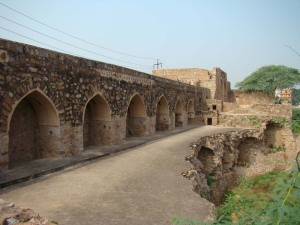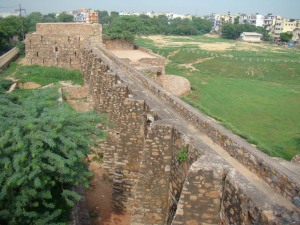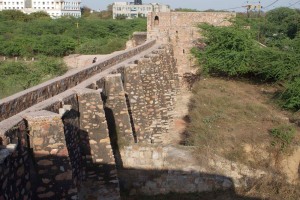Carrying on from last week’s ‘focus monument’, this time it’s another historic waterwork. Like Rajon ki Baoli, not too well-known, though it’s very visible: Satpula, on Press Enclave Road.
As I’d mentioned in my post on Rajon ki Baoli, several of the rulers of Delhi established waterworks to counter the city’s perennial shortage of water. Among the most prolific builders were the three Tughlaq Sultans, Ghiyasuddin Tughlaq, Mohammad bin Tughlaq, and Feroz Shah Tughlaq, who built or restored various waterworks including the Western Yamuna Canal, Hauz Khas, and a twin-dam lake complex at Adilabad.
Among these waterworks is the 65mt high Satpula (literally, ‘seven bridges’, though the term ‘bridge’ in this case is loosely used to mean ‘pier’). Mohammad bin Tughlaq, ascending the throne in the early 14th century, built a whole new city—Jahanpanah—as his capital. Satpula was the dam built into the southern wall of Jahanpanah in order to ensure a supply of water to the fields that lay south of Jahanpanah.
The water from Satpula came from an artificial lake filled by rainwater. The dam or weir was constructed of stone rubble, with seven wooden sluice gates that could be lowered or raised to stop or start the flow of water. Interestingly, the water of the artificial lake was believed to have curative powers, stemming from the belief that the Sufi mystic Naseeruddin Mahmood Chiragh-e-Dehli (after whose dargah Chirag Dilli is named) used its waters to perform wazu, ritual ablutions before namaaz.
The wooden sluice gates of Satpula have long since disintegrated, but the rest of the monument is intact—including the chambers at either end, which in medieval times, housed a madarsa. Winters are a good time to visit Satpula, since the little pond that still exists attracts water birds.
Photographs ©Swapna Liddle




The last sentence about the pond attracting birds made a lovely picture in my mind. Thanks for these posts Madhu. 700 years ago there was a lot going on it seems. How historically rich Delhi is. Amazing.
LikeLike
Thank you! Yes, Delhi has (it seems) always had some very interesting things going on. And the Tughlaq period must’ve been one of frenetic activity – those three men built a lot.
I remember going on a heritage walk to Satpula years ago, and seeing sandpipers in the pond there… very pretty.
LikeLike
do you have any factual data related to the thing you wrote that ‘its an artificial lake’ ?
LikeLike
Well, I have heard at least two well-respected historians (both of them authorities on the history of Delhi) refer to it as such, so I’m willing to believe them.
LikeLike